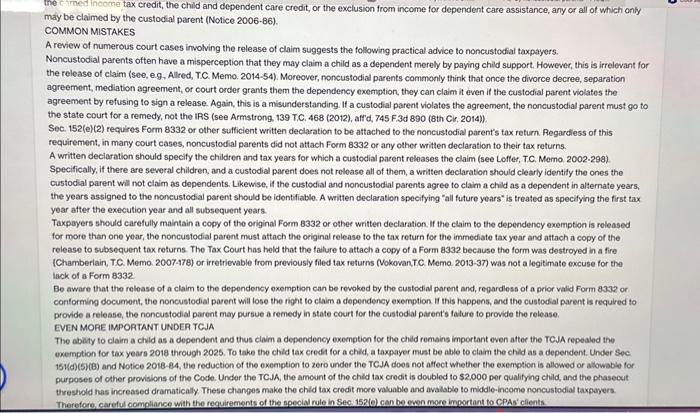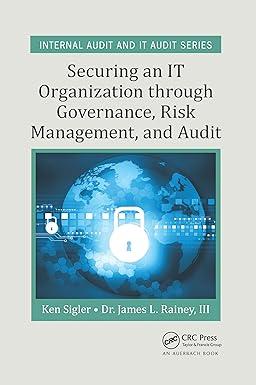Full Text Translate When a couple divorce, the diworce decree may grant the noncustodial parent the right to claim a child or children as dependents for tax purposes. While the law known as the Tax Cuts and Jobs Act (TC.JA), PL. 115.97, reduced the personal exemption for taxpayers, spouses, and dependents to zero for tax years 2018 through 2025 , the special rule of Sec. 152(e) allowing a noncustodial parent to claim a child as a dependent is stil important because it also allows the noncustodial parent to claim a child tax credi, which the TCJA increased and expanded. To claim this tax benefit, however, the noncustodial taxpayer should closely follow the special rule's statutory and regulatory requirements, about which taxpayers of ten have mispenceptions. Sec. 152(e) applies to parents who are divorced, legally separated, or living apart during the last six months of the calendar year and provide more than one-half of the childs support for the calendar year. The chid must be in the custody of one or the other parent for more than half of the year (Sec. 152(e) (1)). If these requirements are met, the custodial parent may then release the right to claim a dependency exemption under Sec. 152(o)(2) to the noncustodial parent. To release his or her claim to the dependency exemption, the custodial parent must sign a written declaration for the years that he or she is not claiming the child as a dependent, which must be attached to the noncustodial parent's tax relurn FORM 8332 OR WAITTEN DECLARATION The IRS issued Form 8332, Release/Revocation of Release of Claim to Exemption for Child by Custodiat Parent, for parents to use to satisfy the Writtendeclaration requrement. Form 8332 requires the custodial parent to furnish the name or names of the child or children for whom the claims are released, the year or years for which the claims are released, the custodial parent's Social Security number (SSN), and the namo and SSN of the noncustodial parent. The custodial parent must also sign and date the form Use of Form 8332 is not mandatory, though, and parents may satisty the Written-declaration requirement by attaching a document conforming to the substance of the form and executed lor the sole purpose of serving as a Written declaration under Sec. 152 (Fogs. Sec. 1152-4(e)001)) A court order, decree, or separation agreement executed in a tax year beginning after July 2,2008 , may not serve as a written declaration. Additionally, the written declaration must be uncond tional. That is, the custodial parent's release cannot require satisfaction of ary condition such as the noncustodial parent's fuifiliment of a child support obligation (Regs. Sec. 11524(e)(0.0) The custodial parent may revoke a written declaration by providing a written notice of revocation to the noncustodial parent (Regs. Sec. 1152-4(e)(3) 0 ). Even if the noncustodial parent may claim the child as a dependent under Sec, 152/e), this does not entitle him or her to head-of household filing status. the earned income tax credit, the child and dependent cace credit, or the exclusion from income for dependent care assistance, any or all of which only the ches income tax credit, the child and dependent care credit, or the exclusion from income for dependent care assistance, any or all of which only may be claimed by the custodial parent (Notice 2006-86). COMMON MISTAKES A review of numerous court cases involving the release of claim suggests the following practical advice to noncustodial taxpayers. Noncustodial parents often have a misperception that they may claim a child as a dependent merely by paying child support. However, this is irrelevant for the release of claim (see, e.9. Alled, T.C. Memo. 2014-54). Moreover, noncustodial parents commonly think that once the divorce decree, separation agreement, mediation agreement, or court order grants them the dependency exemption, they can claim it even if the custodial parent violates the agreement by refusing to sign a release. Again, this is a misunderstanding. If a custodial parent violates the agreement, the noncustodial parent must go to the state court for a remedy, not the IRS (see Armstrong, 139 T.C. 468 (2012), affd, 745 F.3d 890 (8th Cir. 2014)). Sec. 152 (e)(2) requires Form 8332 or other sufficient written declaration to be attached to the noncustodial parent's tax return. Regardiess of this requirement, in many court cases, noncustodial parents did not attach Form 8332 or any other written declaration to their tax returns. A written declaration should specify the children and tax years for which a custodial parent reloases the claim (see Loffer, TC. Merno. 2002-298). Specifically, if there are several children, and a custodial parent does not reloase all of them, a written declaration should clearly identify the ones the custodial parent will not claim as dependents. Likewise, if the custodial and noncustodial parents agree to claim a child as a dependent in alternate years, the years assigned to the noncustodial parent should be identifiablo. A written declaration specifying "all future years" is treated as specifying the first tax year after the execution year and all subsequent yoars. Taxpayers should carefully maintain a copy of the original Form 8332 or other written declaration. If the claim to the dependency exemption is roleased for more than one yoar, the noncustodial parent must attach the original release to the tax return for the immediate tax year and attach a copy of the release to subsequent tax returns. The Tax Court has held that the fallure to attach a copy of a Form 8332 because the form was destroyed in a fire (Chamberlain, TC. Memo. 2007-478) or irretrievable from previously filed tax returns (VokovanTC. Memo. 2013-37) was not a legitimate excuse for the lack of a Form 8332 Be aware that the release of a claim to the dependency exemption can be rewoked by the custodial parent and, repardless of a prior valid Form 8332 or conforming document, the noncustodial parent will lose the right to claim a dependency exemption. If this happens, and the custodial parent is required to provide a release, the noncustodial parent may pursue a remedy in state court for the custodial parent's falure to provide the release. EVEN MORE IMPORTANT UNDER TCJA The abity to claim a child as a dependent and thus claim a dependency exemption for the child remains important even after the TCJA repealed the exemption for tax years 2018 through 2025 . To take the child tax credit for a child, a taxpayer must be able to claim the chid as a dependent. Under Sec 151(d)(5)(8) and Notice 201884, the reduction of the exemption to zero under the TCJA does not affect whether the exemption is allowed or allowable for purposes of other provisions of the Code. Under the TCJA, the amount of the child tax credit is doubled to $2,000 per qualifying child, and the phasecut threshold has increased dramatically. These changes make the child tax credit more valuable and avalable to middle-income noncustodial taxpayers. The ability to claim a child as a dependent and thus claim a dependency exemption for the child remains important even after the TCJA repesled the exemption for tax years 2018 through 2025. To take the child tax credit for a child, a taxpayer must be able to claim the child as a dependent. Under Sec. 151(d)(5)(B) and Notice 2018-84, the reduction of the exemption to zeto under the TC.A does not affect whether the exemption is allewed or allowable for purposes of ether provisions of the Code. Under the TCJA, the amount of the child tax credit is doubled to $2,000 per qualifying child, and the phaseout threshold has increased drametically. These charpges make the child tax credit more valuable and avalable to middle-income noncustodial taxpayers. Therefore, careful compliance with the requirements of the special rule in Sec. 152(e) can be evon more important to CPAs' clents Wei-Chin Chiang. CPA, DBA, andJiarun Du, PhD, are associate peofessors of accounting at the University of Houston-Victoria in Katy, Texas. Karen Pierce, CPA, DBA, is an associate professor of accounting at Morehead State University in Morehead, Ky









